Royal cultural heritage
The Royal Collections include a large number of works of art and practical items, many of which are used in the ceremonial and official duties of the Head of State. Displaying and preserving this royal cultural heritage is one of the Royal Court of Sweden's tasks.
The Swedish Regalia
The Swedish Regalia
The Swedish Regalia are the principal symbols of Sweden's form of government. The kingdom's main regalia are the sword, the crown, the sceptre, the orb and the key. Their symbolism was defined during King Erik XIV's coronation in 1561.
The crown is a sign of regal glory and dignity, the sceptre demonstrates the king's earthly power, the orb represents God's appointment of the king to rule over a large, Christian kingdom, and the sword symbolises how the king boldly defends good and punishes evil. Since 1970, the regalia have been on public display in the Treasury at the Royal Palace.

The main regalia (from left): the key, the sceptre, the sword, the crown and the orb. Photo: Alexis Daflos/The Royal Court of Sweden

King Erik XIV's Crown was last used for ceremonial purposes at the royal wedding in 1976. Photo: Yanan Li/The Royal Court of Sweden

Today, Karl (X) Gustav's Crown of the Heir Apparent represents The Crown Princess, and was last used for ceremonial purposes during her marriage to Prince Daniel in Stockholm Cathedral in 2010. Photo: Alexis Daflos/The Royal Court of Sweden
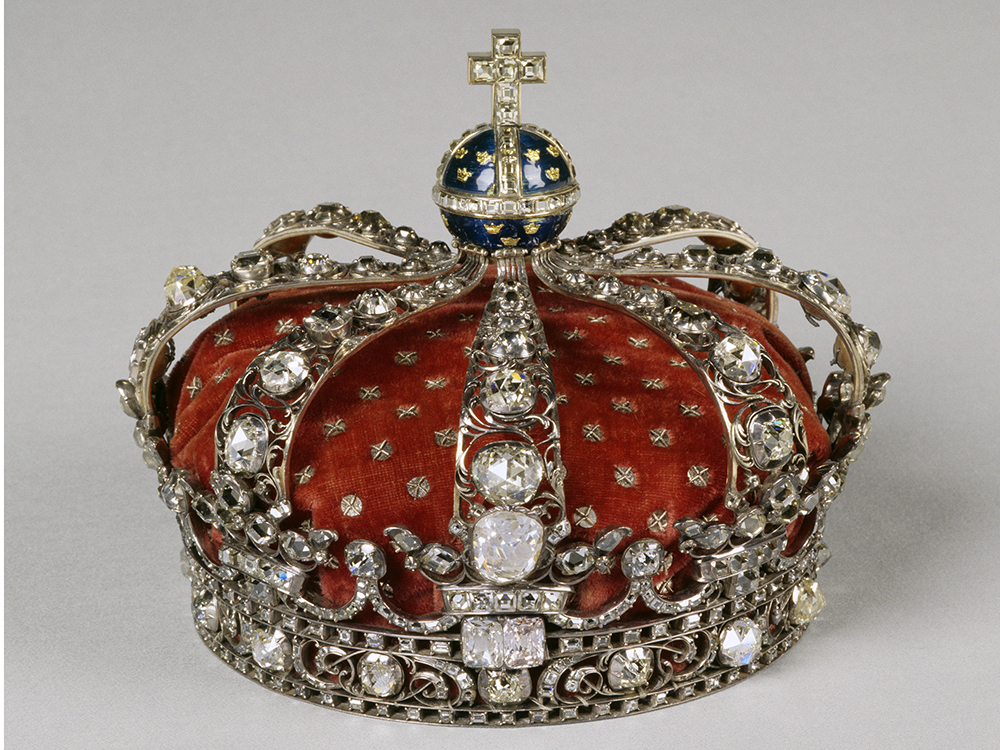
Queen Lovisa Ulrika's Crown is Sweden's Queen's Crown, and was last used for ceremonial purposes at the royal wedding in 1976. Photo: Alexis Daflos/The Royal Court of Sweden
Ceremonial objects
Ceremonial objects
State visits, formal audiences, and church ceremonies such as royal christenings, weddings and funerals are HM The King's state duties. Objects with symbolic meanings have been used on all these occasions. Some are still used to this day, while others have now fallen out of use.
Examples of ceremonial objects include the national banner, the silver throne, the silver baptismal font, the coronation cloak and the ceremonial batons.

The last time the silver throne was used was in 1974, when the ceremonial Opening of the Parliamentary Session took place in the Hall of State at the Royal Palace for the last time. Photo: Alexis Daflos/The Royal Court of Sweden

The silver baptismal font in the Royal Chapel at the Royal Palace before Prince Oscar's christening in May 2016. Photo: Jonas Ekströmer/TT

The last time the coronation mantle was used for ceremonial purposes was during the ceremonial Opening of the Parliamentary Session in 1974, when it was draped over the silver throne. Photo: Leif R Jansson/TT
Furniture
Furniture
Sweden's largest collection of historic furniture can be found at the royal palaces. At the Royal Palace, furniture from many generations form part of the traditional setting for HM The King's official duties. Other castles and palaces such as Gripsholm, Rosersberg, Rosendal and Gustav III's Pavilion in Haga Park are primarily historic attractions, and feature older items of furniture that are often unusually well preserved.
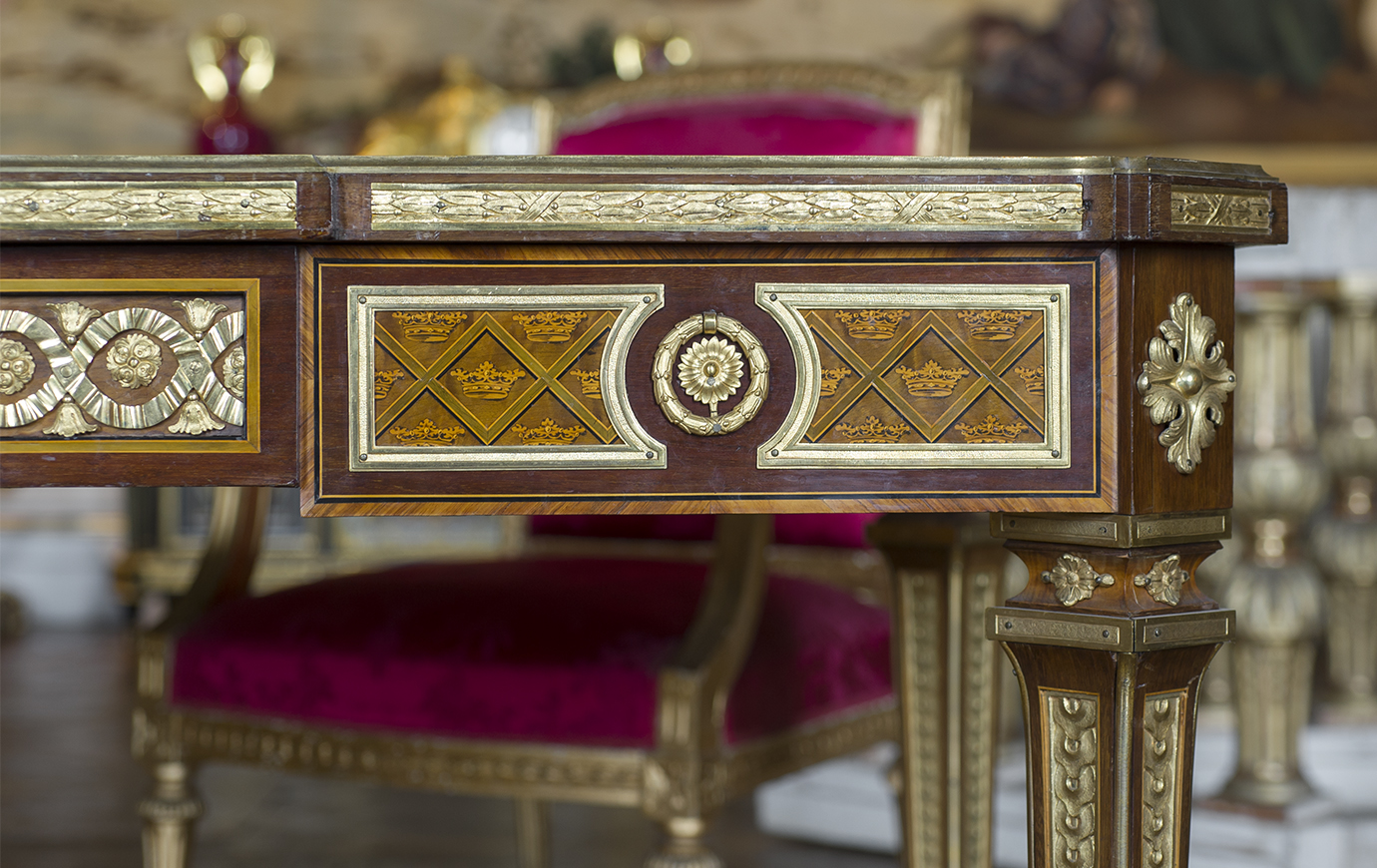
King Gustaf III's desk, built by Georg Haupt. The desk stands in King Gustav III's State Bedchamber, in the State Apartments at the Royal Palace. Photo: Alexis Daflos/The Royal Court of Sweden

King Carl XVI Gustaf's Jubilee Room dates from the 1990s, and is used for royal functions. The room is also open to the many tourists who visit the Royal Palace each year. Photo: Sara Friberg/The Royal Court of Sweden
Visual arts
Visual arts
The art at the royal palaces consists of pieces from the royal and state collections. The emphasis of today's collections is on portraits. Portraits of the current Bernadotte dynasty from King Karl XIV Johan and Queen Desideria to King Carl XVI Gustaf and Queen Silvia are on display in the Bernadotte Apartments at the Royal Palace. The portraits from different generations reflect their own times and artistic standards.
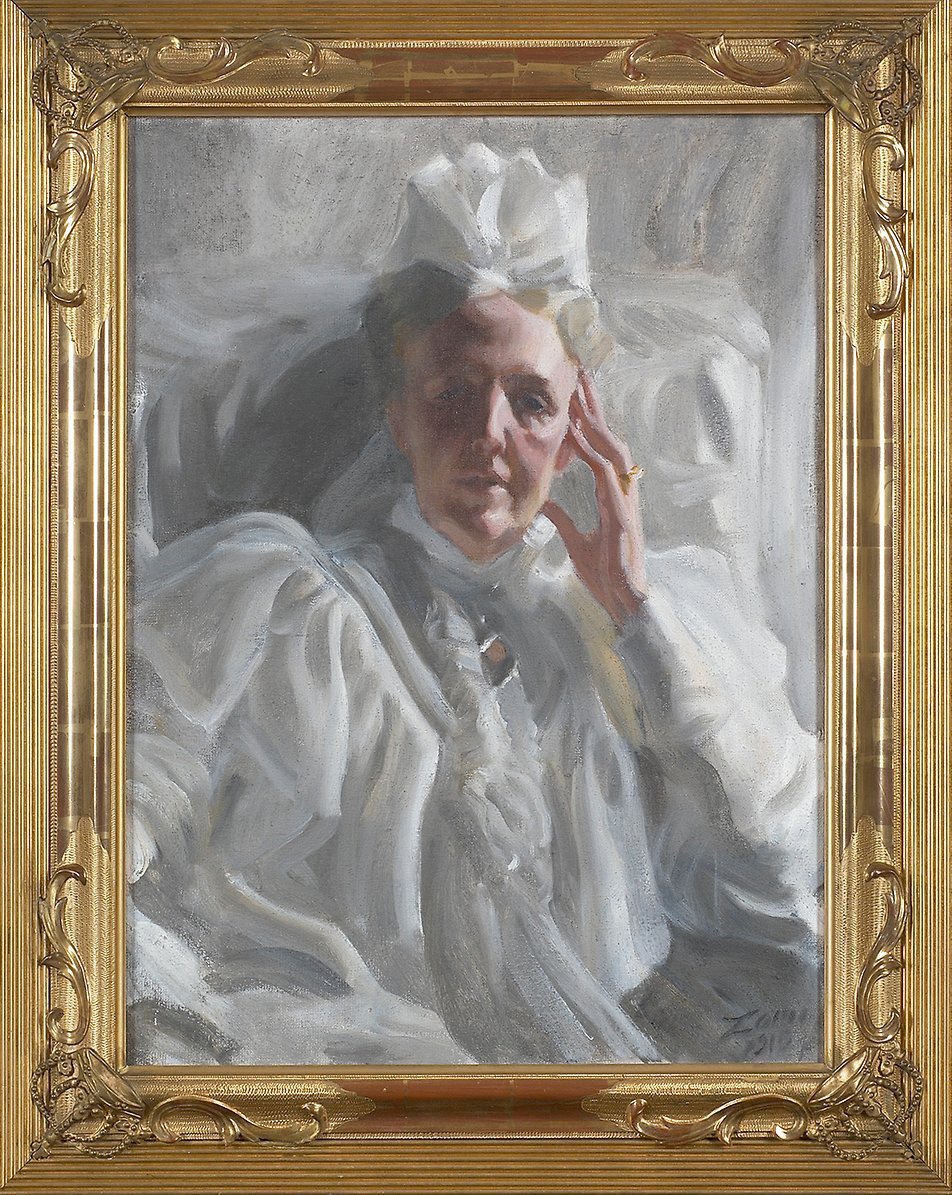
Portraits of our current royal dynasty can be seen in the Bernadotte Gallery at the Royal Palace. They include this portrait of Queen Sofia, painted by Anders Zorn. Photo: Alexis Daflos/The Royal Court of Sweden
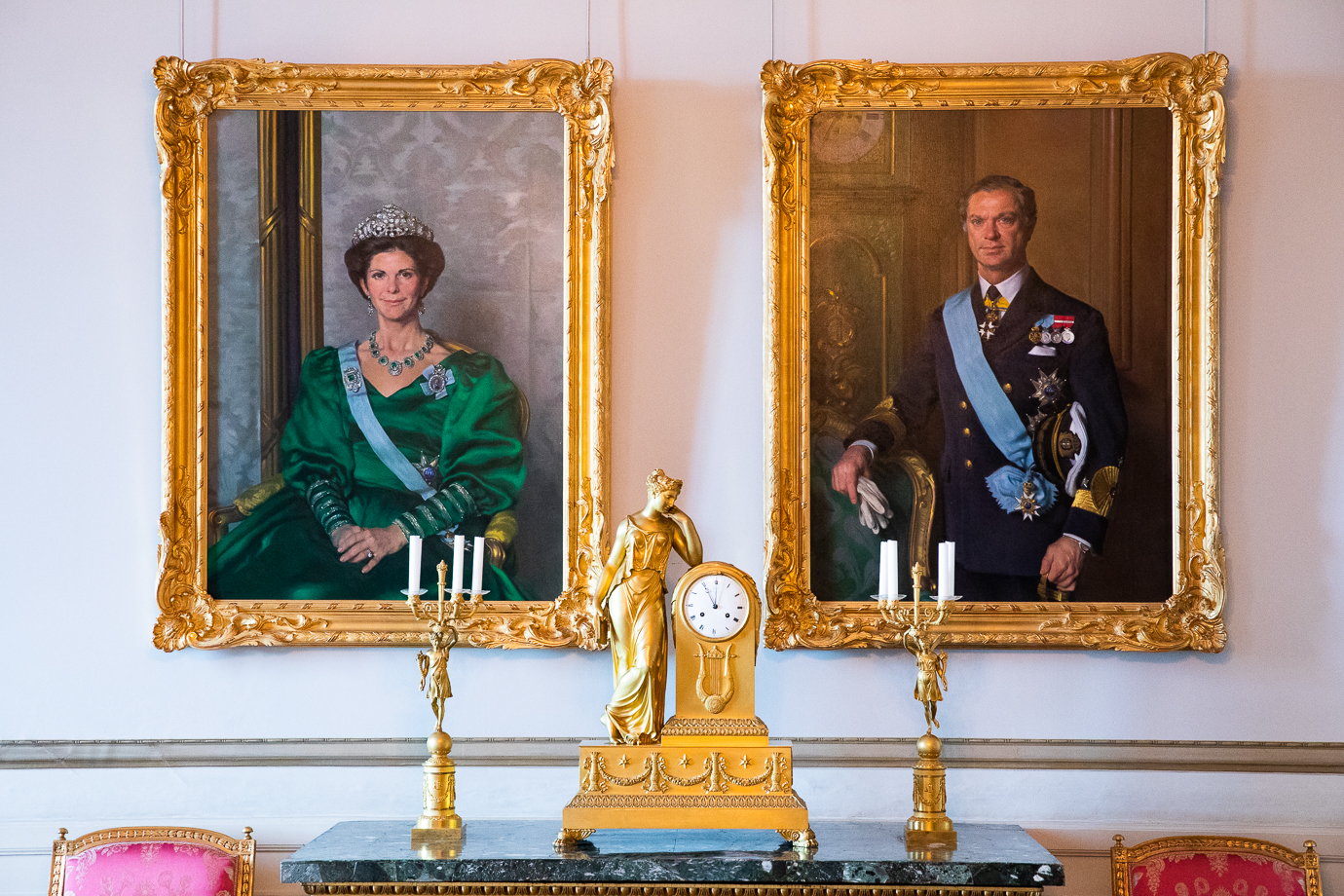
Nelson Shanks' portrait of The King and Queen. Photo: Sara Friberg/The Royal Court of Sweden
The Treasury Collection
The Treasury Collection
The Treasury Collection includes silver cups, turned ivory pieces, and bowls made from semi-precious stones, rock crystal or coral, often with gold and enamel mountings.
The Treasury Collection makes up the oldest part of the royal art collections, and features objects that can be traced back to King Gustav II Adolf in the 1630s. Certain items have been presented as official gifts, while others have been acquired from around Europe. Some were spoils of war from the Thirty Years' War (1618–1648) and King Karl X Gustav's military campaigns in Denmark and Poland.

Cup, partly in gilded silver, in the form of Atlas carrying a celestial globe. Made in Nuremberg by goldsmiths Christoph Jamnitzer (1593–1618) and Jeremias Ritter (1605–1646). The top of the globe can be lifted off, and Minerva – the goddess of wisdom – stands on the top. Presented as a gift to King Gustav II Adolf by the citizens of Nuremberg on his entry into the city on 31 March 1632. Photo: Alexis Daflos/The Royal Court of Sweden
x1000.jpg)
Ivory and silver salt cellar, depicting the triumph of Venus. Made by Georg Petel in Antwerp during 1627–28, from drawings by Peter Paul Rubens. Purchased at auction on behalf of Queen Kristina after Ruben's death in 1646. Photo: Alexis Daflos/The Royal Court of Sweden
Silverware and bronzes
Silverware and bronzes
Silverware has a natural place as part of a table setting. Throughout the ages, the Royal Court's ceremonial dining has reflected the splendour of the kingdom and expressed generosity towards the guests of the monarch. HM The King's official banquets still serve the same function to this day.

Close-up of a piece from the Brazilian silver service used at HM The King's official banquets. Photo: Sara Friberg/The Royal Court of Sweden

In 1781, King Gustav III purchased a ceremonial service that Gustaf Philip Creutz had commissioned a few years previously for his official engagements as ambassador in Paris. The service was of the very finest quality. It was manufactured by Robert-Joseph Auguste, who supplied similar dinner services to several European royal courts. The picture shows one of the two soup tureens. Photo: Magnus Persson/The Royal Court of Sweden
Glass and porcelain
Glass and porcelain
Table settings have always been an important way for a royal court to demonstrate its unique status. The various pieces have their own practical functions, but should also convey the position of the nation and enhance the dining experience.
Today, the royal table features pieces made of glass, porcelain and silver. This has been the case ever since the 18th century.

Glass service made by Kosta Glassworks, designed by Sigurd Persson. The service was a gift from the Riksdag and the Swedish Government on Their Majesties' wedding in 1976, and is often used for royal entertaining. Photo: TT
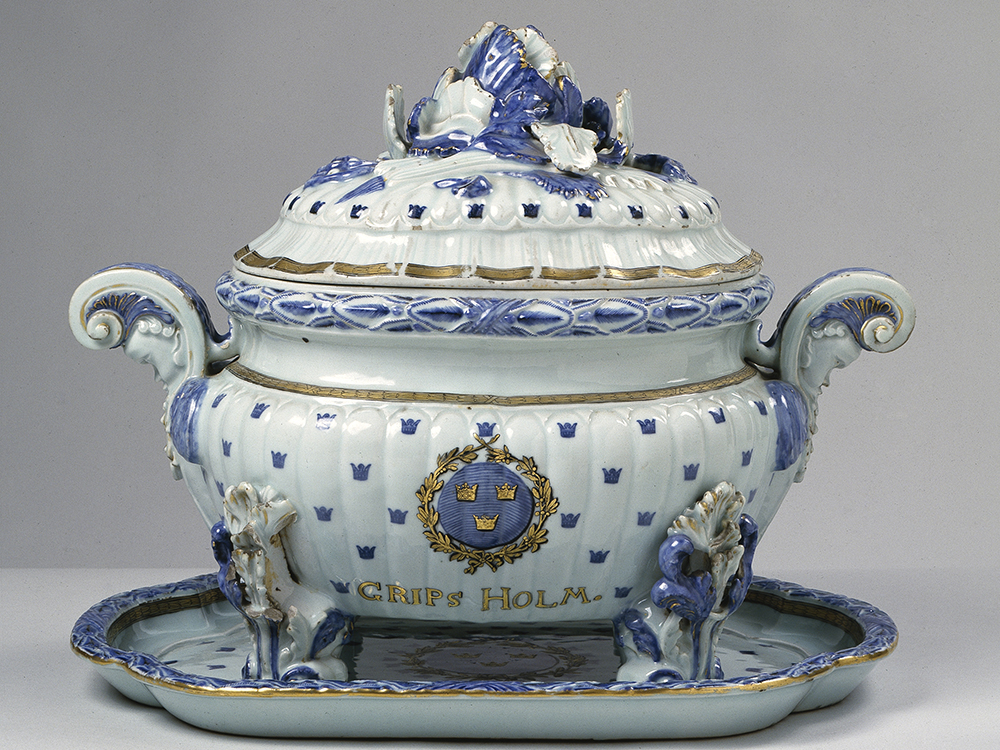
Tureen with dish from King Gustav III's Gripsholm service, made in China in 1775. The service was a gift to the king, presented by the Swedish East India Company in 1776. It originally consisted of about 700 pieces. In the 1810s, the service was considered unusable and the remaining pieces were sold at auction in 1819. Some of the service was reunited thanks to King Oskar II's efforts in the 1890s. Photo: Alexis Daflos/The Royal Court of Sweden
Textiles and rugs
Textiles and rugs
The brightly coloured carpets and textiles in the Royal Collections demonstrate exquisite craftsmanship. They are important features of the royal interiors, including both practical and symbolic features, and are carefully preserved for future generations.

18th century bedcovers with brightly coloured printed patterns are kept in Gripsholm Castle's storehouse. Photo: Alexis Daflos/The Royal Court of Sweden

One of the Savonnerie rugs was used in the chapel during Prince Alexander's christening in 2016. Photo: Sanna Argus Tirén/The Royal Court of Sweden
Clocks
Clocks
The chiming clocks on the hour and the half hour remind visitors to the Royal Palace that this is a living environment and the Head of State's residence. During ceremonies and other official programme items, clocks serve the practical function of measuring time, in a way that we now take for granted.

The Oath of the Horatii. Photo: Alexis Daflos/The Royal Court of Sweden
Books and illustrations
Books, congratulatory addresses, maps and illustrations
Today, the Bernadotte Library houses extensive collections of books, photographs, maps, illustrations, sheet music and congratulatory addresses that belonged to the Bernadottes. The library now serves as a library museum and a research library focusing on the personal history of the Bernadotte dynasty.

The Bernadotte Library. Photo: Alexis Daflos/The Royal Court of Sweden

The Habsburg Marriage Book. Photo: Jessica Gow/TT
Photographs
Photographs
The Bernadotte photograph collection consists of approximately 500,000 images. This is a unique and carefully preserved collection that documents the history of photography, from its inception in 1839 onwards. It also serves as a visual depiction of the Bernadotte family.

Daguerreotype of Duke Wilhelm of Nassau (1792–1839). Duke Wilhelm was Queen Sofia's father. Since the birth of photography is usually attributed to 1839 and Duke Wilhelm died in August that year, it is reasonable to assume that the portrait dates from 1839.
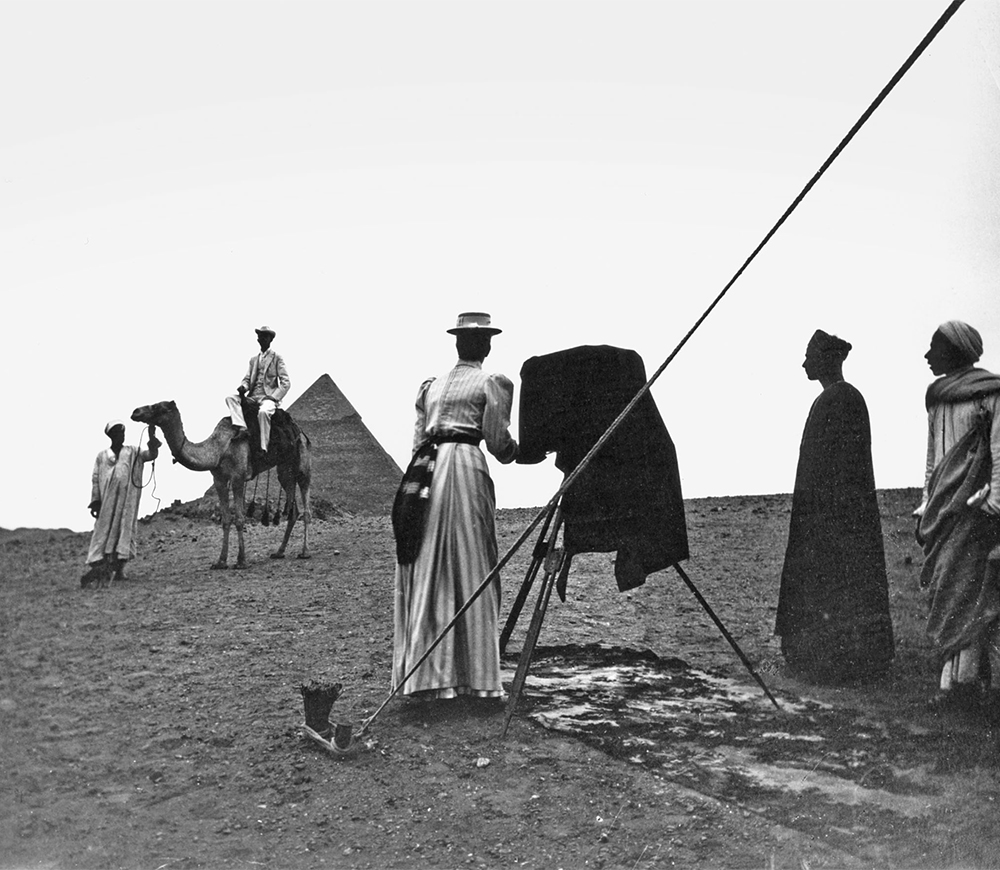
Queen Victoria photographs the pyramids in Egypt. Photo from the Bernadotte Library's image archive.
Sheet music
Sheet music
The Bernadotte Library's collections include an extensive collection of sheet music, made up of approximately 6,000 printed and handwritten pieces of music. It includes compositions by several of the second and third generations of the Bernadotte family. King Oskar II was a talented singer who liked to perform music on his pump organ, and many of the collection's printed works belonged to him and to Queen Victoria.

King Oscar II at the organ, on board the HMS Drott. Summer 1900. From the 1900 Drott commemorative album.
Carriages and cars
Carriages and cars
The main task of the Royal Stables is to meet the Royal Family's everyday and ceremonial transportation needs. Its coach sheds are home to around forty carriages and sledges for various purposes, including the famous Sjuglas State Carriage.

The Sjuglas State Carriage dates from 1897 and is still used for the Opening of the Parliamentary Session, state visits and formal audiences. Photo: Charlotte Gawell/The Royal Court of Sweden
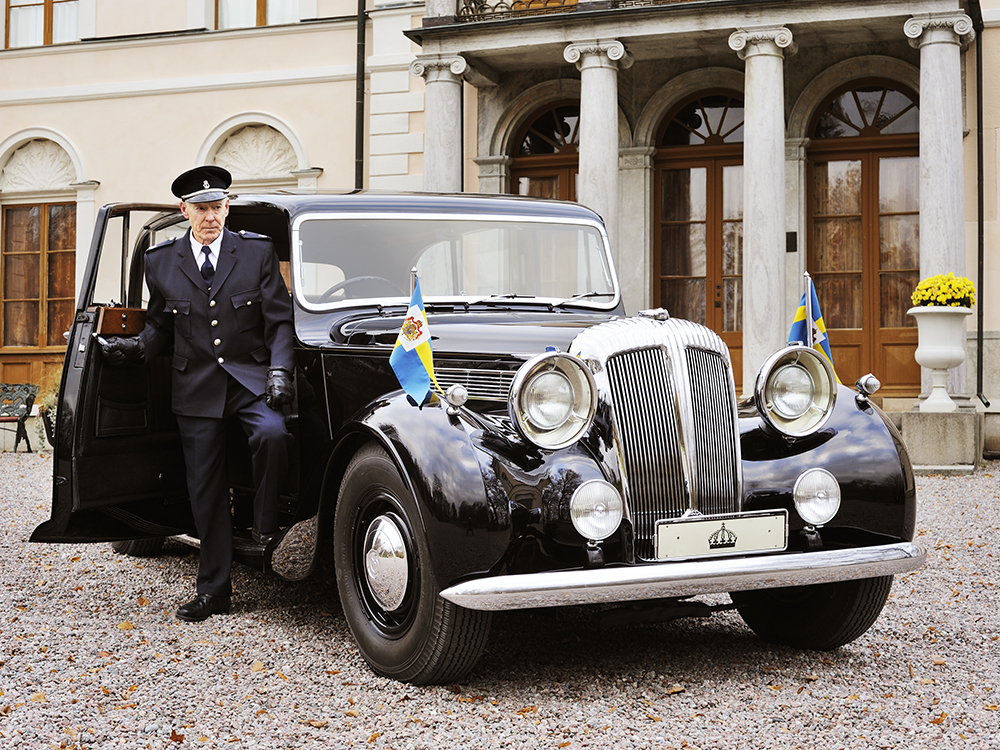
The 1950 Daimler Limousine is the Royal Stables' oldest and perhaps most comfortable car. It is still used on special occasions. Photo: Charlotte Gawell/The Royal Court of Sweden
Uniforms
Uniforms and service dress
Both uniforms and service dress are used within the Royal Court. These garments show the role and position of the wearer, and add to the experience of various ceremonies and events. Some uniforms are used on a daily basis at the Royal Court, while others are worn only on special occasions such as state visits and formal audiences.
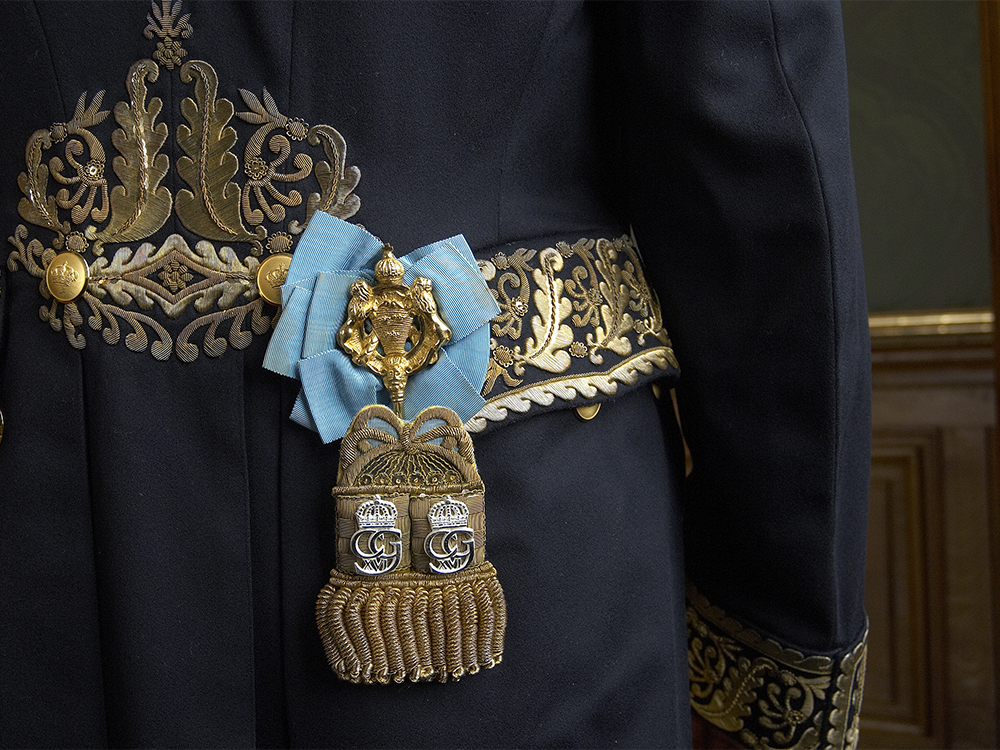
Cabinet chamberlain's key. Close-up of reverse with gold embroidery on court uniform. Photo: Alexis Daflos/The Royal Court of Sweden
Jewellery
Jewellery
Few things give the same sense of occasion as opulent jewellery. The sparkling stones and precious metals have their own special radiance. The jewellery in the Royal Collections has been passed down through many generations, intimately linking it to bygone times, historic events and royal family connections.

The Cameo Tiara. Photo: Lisa Raihle Rehbäck/The Royal Court of Sweden

This necklace of brilliants and pink topaz was made in St Petersburg around 1800. Photo: Lisa Raihle Rehbäck/The Royal Court of Sweden


